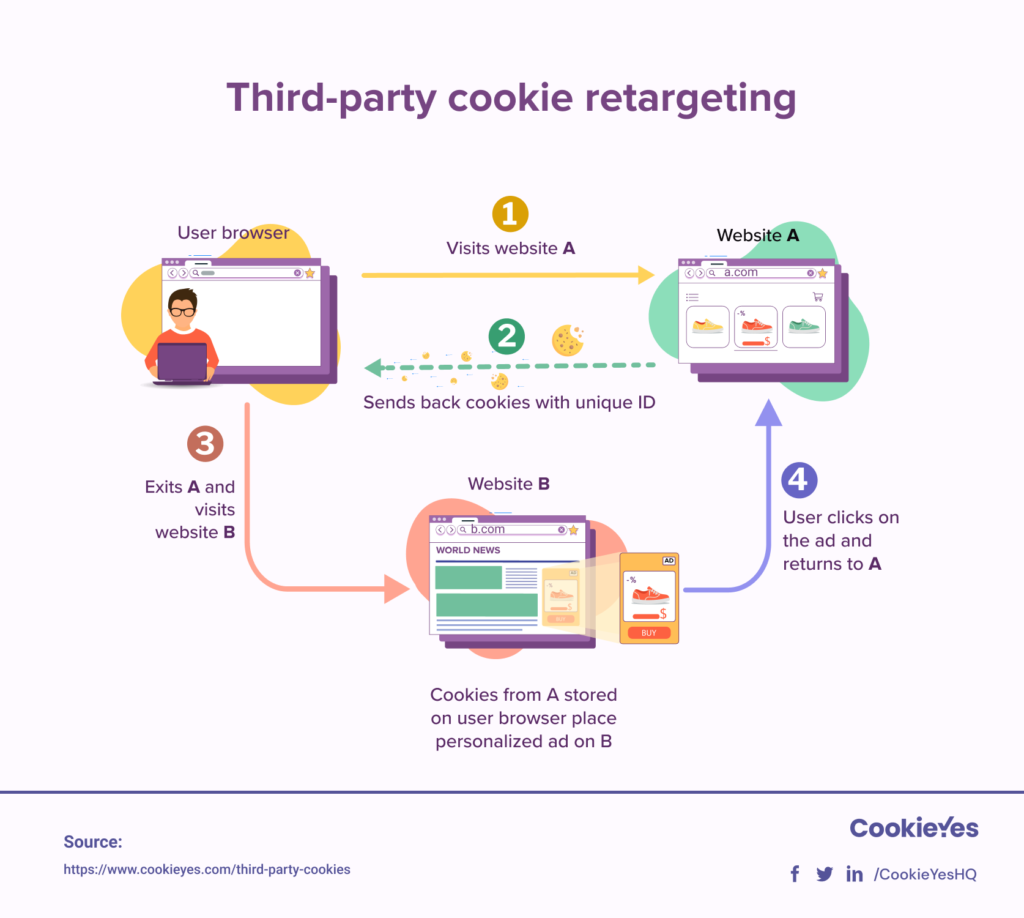Have you ever been looking at a website for a pair of shoes? You might see an advertisement for those shoes a week later when reading the news on your web browser. This is what third party cookies do.
Basically, cookies are small text files saved in your internet browser or device when you go to a website. They are used to identify your browser and/or device and are used to track certain aspects of your online behaviour.
Not all cookies are made equal. Some cookies are only first party cookies. These help to gather information about you that would make the website more useful for you.
Some things cookies may identify are:
- Website name
- Browsing habits and history
- Personal preferences and history
- IP address
- Phone number and address
- Links clicked
- Shopping cart items
Third party cookies track a user’s activity across websites apart from the one they are currently on. They then use that information to make targeted ads. Google and other linked services use these to display and personalise advertisements. This means that more relevant recommendations and advertisements will appear while browsing.

This often happens without the user’s consent, which is why Google was trying to reduce them.
Google announced a plan to allow more privacy with online browsing in January 2020. This announcement claimed that they would phase out third party cookies by the end of 2022. Advertisers and marketers were worried this would cause a 60% drop in ad revenues. It is now nearly 2025 and third party cookies are still around, so what gives?
Instead of getting rid of third party cookies entirely, they have changed the way users can control them. Google’s Privacy Sandbox was an initiative created in 2019 as an alternative to cookies. Its goal is to enhance online privacy while still supporting digital businesses as cookies are phased out.
Basically, the Privacy Sandbox encompass the following key elements:
- Shifting data processing and ad targeting to the local browser internet
- Phasing out support for third-party cookies in Chrome
- Introducing a new application programming interface (API) for alternatives to common web use cases
- Providing users with more control over their data and online privacy
- Developing open standards for these new technologies in collaboration with the new web community.
This initiative was created so users could have control over their privacy settings while still giving advertisers access to ad revenue.
These controls include:
- Your choice of ad content, called ‘Ad Topics’ which allow specific ads a user is interested in
- Control of suggested ad content
- User interface options like Google consent mode
According to Google, removing third party cookies with no alternative saw a 34% drop in programmatic revenue for advertisers using Google Ad Manager. When Google used Privacy Sandbox features, Ad Manager users saw a 20% drop instead.
There have been some concerns surrounding the Privacy Sandbox:
- Privacy Sandbox is anticompetitive. Google is the sole controller, they can adjust how it operates, what data it makes available and so on.
- Consumer privacy disclosures are inadequate. This is because privacy disclosures are often difficult to explain in simple terms.
- Topics can be used for fingerprinting. Researchers found that analysing as little as three topics a user is interested in is enough to provide data to identify them.
In an online world on its way to being cookieless, testing continues to be front and centre. One of the main suggestions is to transition to using first party data from direct customer engagement.
Another suggestion is consent-based marketing. Consent-based marketing, or permission marketing, means only showing ads to users who have given permission to do so. It helps to use targeted ads without privacy concerns. It can personalise the customer experience and uses predictive analysis to better understand future trends and behaviours.
With consent-based marketing, this allows you to chase warm leads. These are users who are already receptive to your brand’s message. They allow you to send ads and already care about what you are trying to sell.
Permission marketing examples include:
- Web push notifications
- Chatbot marketing
- SMS and email marketing
Research will continue to be done to try and navigate an online landscape without third party cookies. Advertisers have until 2025 to develop alternatives to create a safer online experience for consumers. Many people already browse in a “cookieless” landscape. Regardless of whether or not marketers want them to, cookies will go extinct. There is nothing to be done about that.
All advertisers can do is look for alternatives and rethink their approaches to different techniques.
